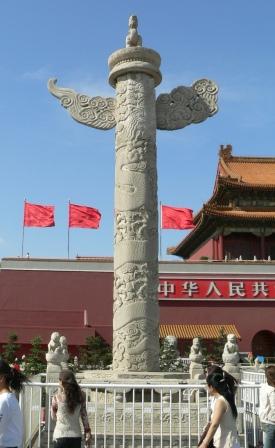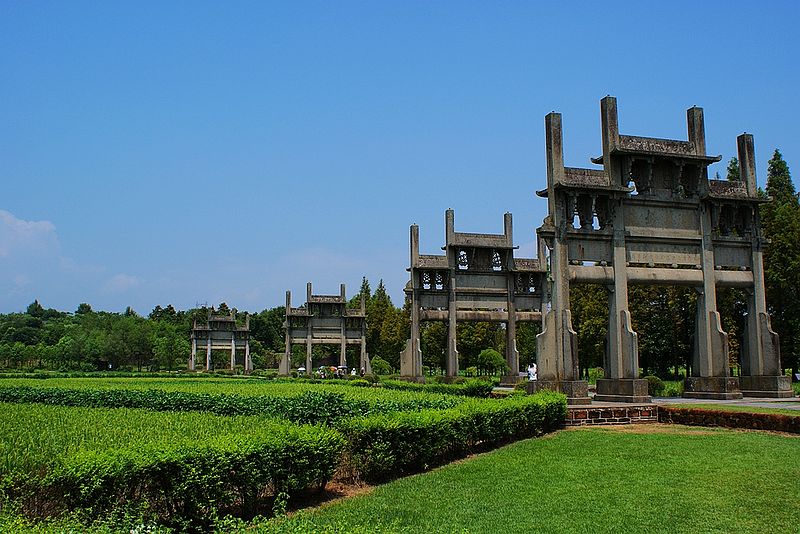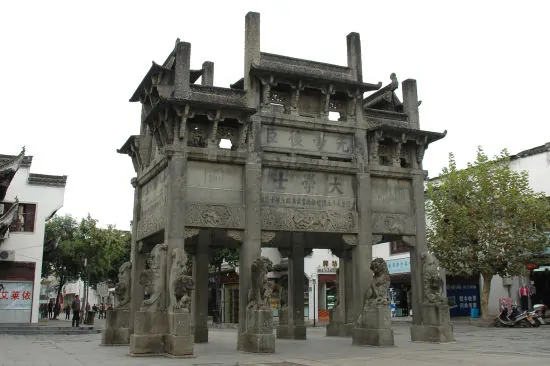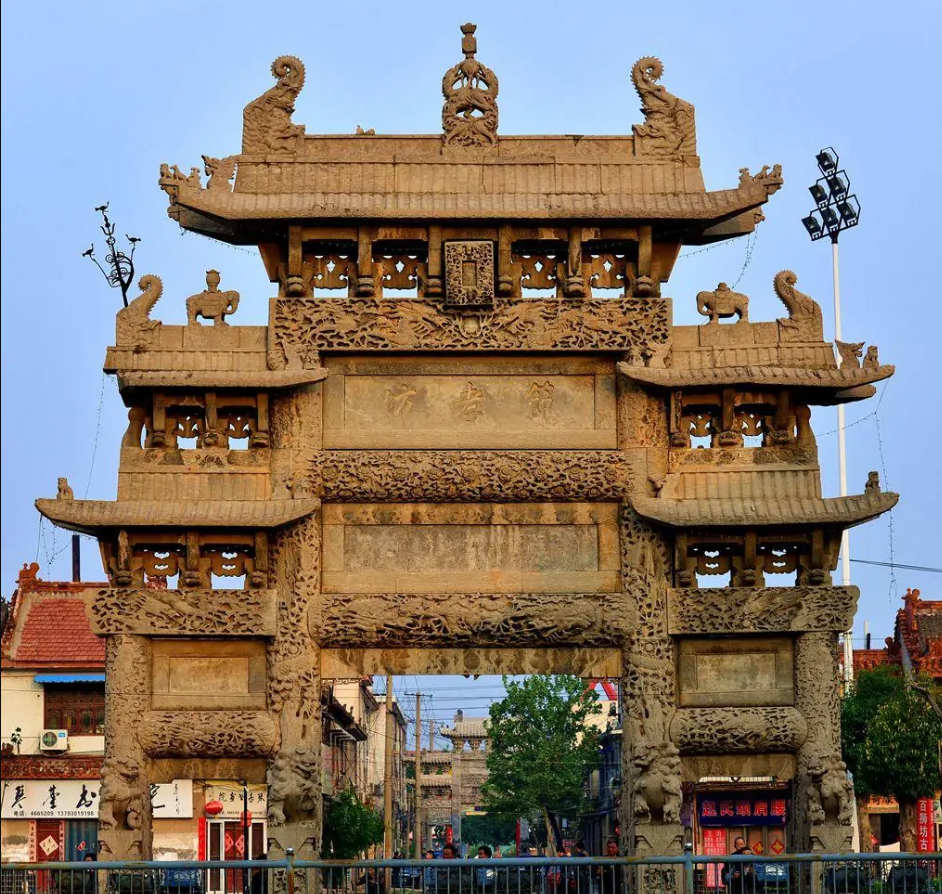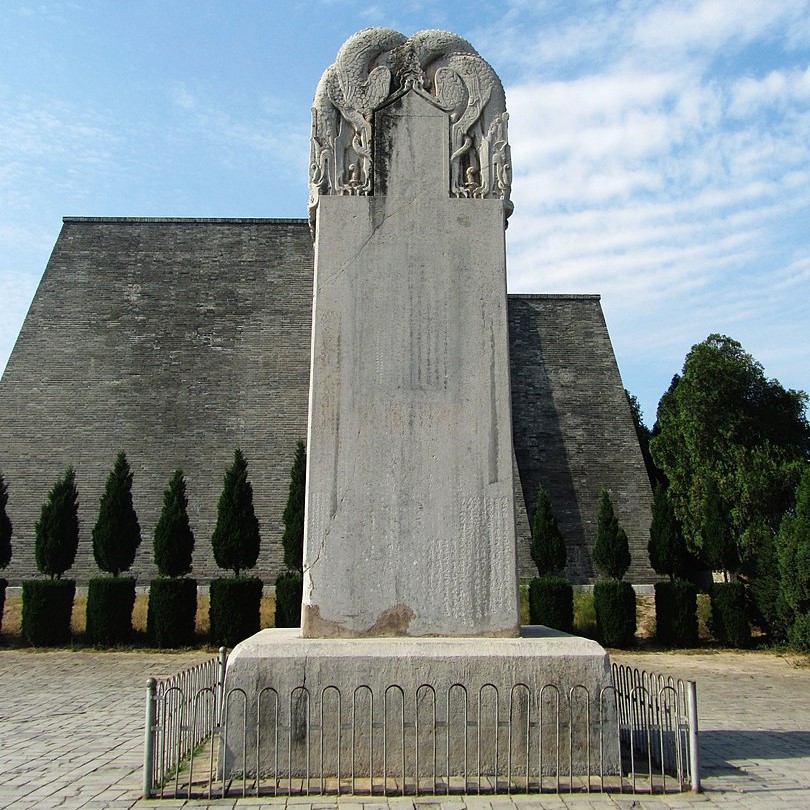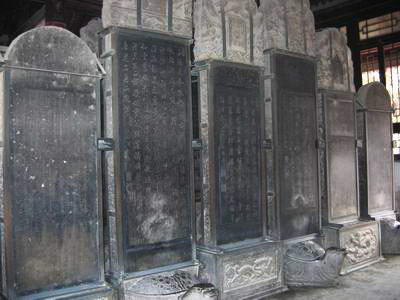4. Decorative Architecture
Ancient Chinese architecture, besides its grand and majestic main structures, also features decorative buildings around them to create harmony, rhythm, rigor, and variation. Common decorative structures in China include huabiao (华表), paifang (牌坊), steles (碑), and yingbi (影壁). They serve not only as adornments but also fulfill commemorative functions.
Huabiao (华表): Huabiao, decorated pillars, are typically erected at palace gates, bridgeheads, or in front of tombs. They became quite common during the Han Dynasty (206 BC – 8 AD). The modern form of huabiao began during the Northern and Southern Dynasties (420 AD – 589 AD), featuring a circular disk carved at the top of the pillar, often depicting a squatting mythical beast called a “bixie” (辟邪). Beijing has the most huabiao in China today.There are four stone huabiao at both ends of the Marco Polo Bridge (also called Lugou Bridge 卢沟桥) in Beijing, with pillars adorned with cloud patterns and lion statues crouching atop lotus-shaped disks. In front of Tiananmen Square (天安门) in Beijing, there are four huabiao with dragon carvings on the pillars, cloud patterns across the beams, circular disks at the tops, and “hou” (犼 a mythical creature known for loyalty and integrity) crouching atop. A pair of huabiao faces north, known as “looking forward to the monarch’s outing” (望君出), urging the emperor to inspect the people’s conditions outside the palace. Another pair faces south, known as “looking forward to the monarch’s return” (望君归), reminding the emperor who is touring or entertaining outside to return promptly to handle state affairs.
Paifang (牌坊): Paifang is a decorated archway, serving decorative, commemorative, and honorific purposes. The origin of paifang is related to huabiao, since it was formed by adding a crossbeam between a pair of huabiao. Paifang are commonly found at bridgeheads, temple entrances, tomb entrances, and street corners, commemorating virtuous women, loyal sons, filial children, loyal ministers, and scholars. Further development led to pailou (牌楼), which mimics traditional Chinese buildings with brackets, overhanging eaves, and upturned corners, typically with three or five bays with the middle and biggest bay to facilitate the passagers and vehicles. Shexian County in Anhui Province is densely populated with paifang and pailou. Outside the city, the “Tangyue Archway Cluster” (棠樾牌坊群) consists of seven archways, built during the Ming and Qing Dynasties by the local Bao clan to honor outstanding family members. Within the city, the “Xuguo Stone Archway” (许国石牌坊) is a rare Ming Dynasty stone archway shaped like the character “口”, commemorating the achievements of the Xuguo (1527 AD – 1596 AD), one of the Ministers of Personnel and the Grand Secretaries. Additionally, in Dan County, Shandong Province, there is a pair of “Bai Shi Fang” (百狮坊) and “Bai Shou Fang” (百寿坊), each adorned with one hundred differently shaped lions (狮) and one hundred different fonts for the character “Shou” (寿).
angyue Archway Cluster” (棠樾牌坊群), Shexian County, Anhui province, China
Xuguo Stone Archway
“Bai Shi Fang” (百狮坊), Dan County, Shandong province, China
Steles (碑): Steles commonly were erected in front of tombs, halls, and temples to sing praises and extol virtues. Rich families even hired renowned calligraphers at great expense to write inscriptions on the steles. Therefore, the preserved inscriptions on steels became precious historical and calligraphic materials. It’s also common to see the steles installed on the backs of giant turtles. The Beilin Museum (碑林) in Xi’an, Shaanxi Province, and the Stele Forest in the Confucius Temple in Shandong Province are concentrated areas of ancient steles. The largest extant stele which is a tombstone in China is in Suzhou City, Jiangsu Province, standing over nine meters (about 30 feet) tall, with over thirteen thousand characters of inscriptions, belonging to the tombstone of Han Shizhong (韩世忠 1089 AD – 1151 AD), a Chinese military general, poet, and politician in Song Dynasty.
Wordless Stele is located at Qianling Mausoleum, the tomeb of Emperor Gaozong and Empress Wu Zetian of the Tang Dynasty. This stele, erected by Wu Zetian, is notable for its lack of inscription. It stand about 23 feet tall and remains blank, symbolizing either an invitation for further generations to judge her legacy or the notion that her achievements were too grate to be captured in words.
Four steles in the Confucius Temple in Shandong Province, China
Yingbi (影壁, also called Zhaobi照壁): When a screen wall is built outside of a gate of a residence, a temple, or a garden, it is called “zhaobi” (照壁). When it is positioned inside, it’s called “yingbi” (影壁). In ancient China, yingbi or zhaobi differentiate the social status of the buildings. Starting from Yuan Dynasty (1206 AD – 1368 AD), Zhaobi were installed in common buildings as the announcement board to publicly post the crimes and penalty of the family. Subsequently, zhaobi in the rich family evolved into fashionable adjunct architectural elements, featuring meticulous designs, craftsmanship, and materials. One of the most exquisitely preserved zhaobi is the “Nine Dragon Screen” (九龙壁) built during the Ming Dynasty (1368 AD – 1644 AD) in Datong, Shanxi Province. It spans 45.5 meters (about 150 feet) in length, stands 8 meters (about 27 feet) tall, and is 2 meters (7 feet) thick, with a roof resembling wooden pavilion structures and covered by glazed tiles.

